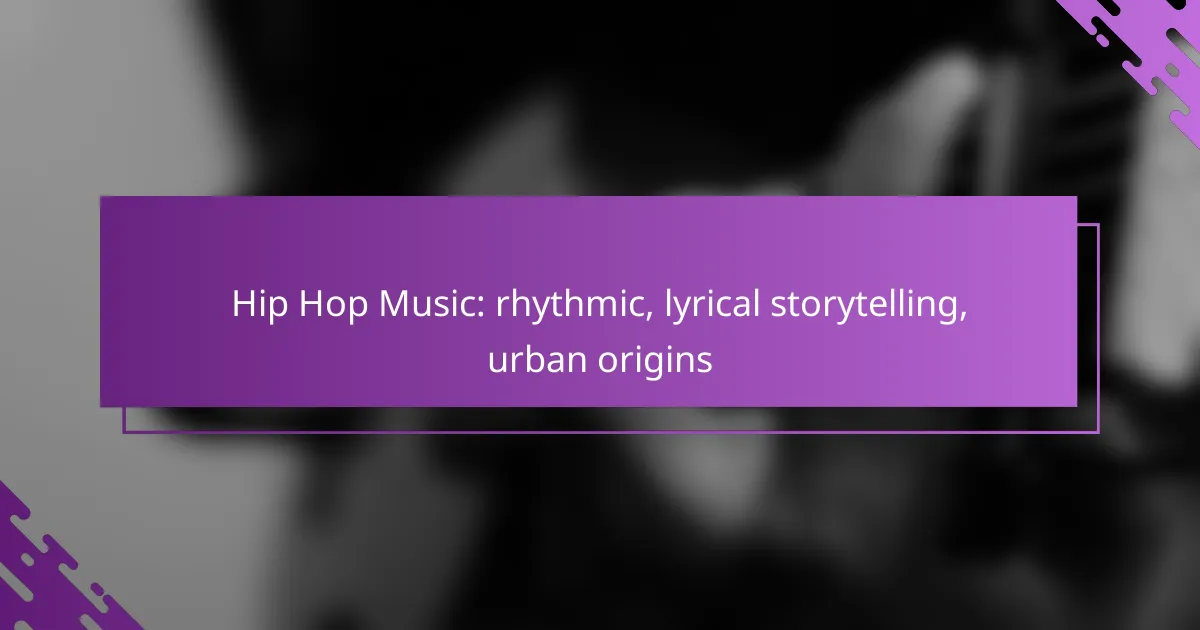Hip Hop music is a dynamic genre that serves as a powerful medium for expression and social commentary, deeply rooted in urban culture. With its distinctive rhythmic beats and lyrical storytelling, it captures the essence of city life and reflects the experiences of diverse communities. Since its emergence in the 1970s, Hip Hop has evolved significantly, adapting to cultural shifts and technological advancements while maintaining its core identity.
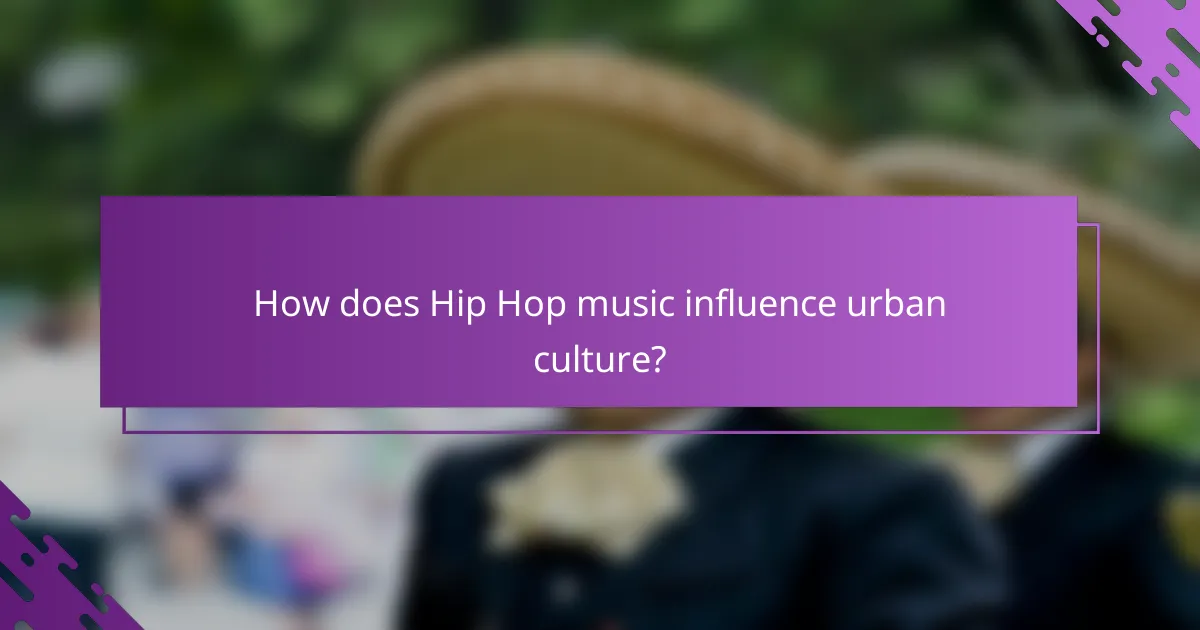
How does Hip Hop music influence urban culture?
Hip Hop music significantly shapes urban culture by serving as a powerful medium for expression, social commentary, and community identity. Its rhythmic beats and lyrical storytelling resonate deeply within city environments, influencing various aspects of daily life and cultural trends.
Social movements
Hip Hop has been a catalyst for numerous social movements, addressing issues like racial inequality, police brutality, and economic disparity. Artists often use their platforms to raise awareness and mobilize communities, exemplified by songs that highlight social injustices and call for change.
For instance, tracks like “Fight the Power” by Public Enemy and “Alright” by Kendrick Lamar have become anthems for activism, inspiring listeners to engage in protests and advocacy. This connection between music and social action fosters a sense of unity and purpose among urban populations.
Fashion trends
The influence of Hip Hop on fashion is profound, with styles emerging from the genre that reflect urban identity and creativity. Baggy jeans, oversized shirts, and branded sneakers are just a few examples of clothing that have been popularized through Hip Hop culture.
Streetwear brands often collaborate with Hip Hop artists, creating limited-edition pieces that resonate with fans. This synergy between music and fashion not only shapes personal style but also drives economic trends within urban markets.
Language and slang
Hip Hop has significantly impacted language and slang, introducing new terms and expressions that permeate everyday conversation. Phrases like “lit,” “dope,” and “flex” have become mainstream, often originating from lyrics and the culture surrounding the genre.
This evolution of language reflects the dynamic nature of urban communication, where Hip Hop artists serve as linguistic innovators. Understanding these terms can enhance cultural appreciation and foster connections within diverse communities.
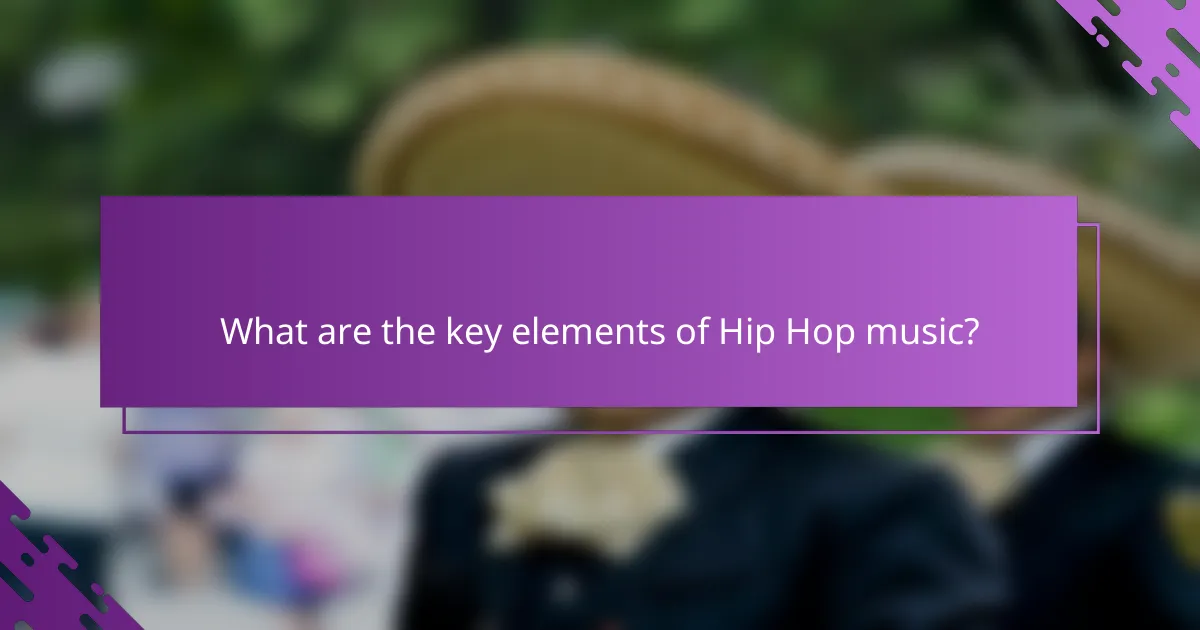
What are the key elements of Hip Hop music?
The key elements of Hip Hop music include rhythm and beats, lyrical storytelling, and sampling techniques. These components work together to create a unique sound and cultural expression rooted in urban experiences.
Rhythm and beats
Rhythm and beats form the backbone of Hip Hop music, often characterized by a strong, steady tempo. Producers typically use drum machines and software to create intricate beats that can range from simple patterns to complex arrangements.
A common approach is to utilize a 4/4 time signature, with a kick drum on the first and third beats, and a snare on the second and fourth. This creates a driving force that encourages movement and engagement, essential for dance and performance.
Lyrical storytelling
Lyrical storytelling is a hallmark of Hip Hop, where artists convey personal experiences, social issues, and cultural narratives through their verses. The lyrics often reflect the realities of urban life, addressing themes such as struggle, resilience, and identity.
Effective storytelling in Hip Hop involves using vivid imagery, metaphors, and wordplay to connect with listeners. Artists frequently draw from their own backgrounds, making their messages relatable and impactful.
Sampling techniques
Sampling techniques involve taking snippets of existing recordings and incorporating them into new tracks, a practice that is foundational in Hip Hop production. This can include anything from a few seconds of a song to longer segments, creating a rich tapestry of sound.
Producers often select samples from various genres, including funk, soul, and jazz, to add depth and texture to their beats. However, it’s crucial to navigate copyright laws carefully, as unauthorized sampling can lead to legal issues. Many artists now seek licenses or use royalty-free samples to avoid complications.
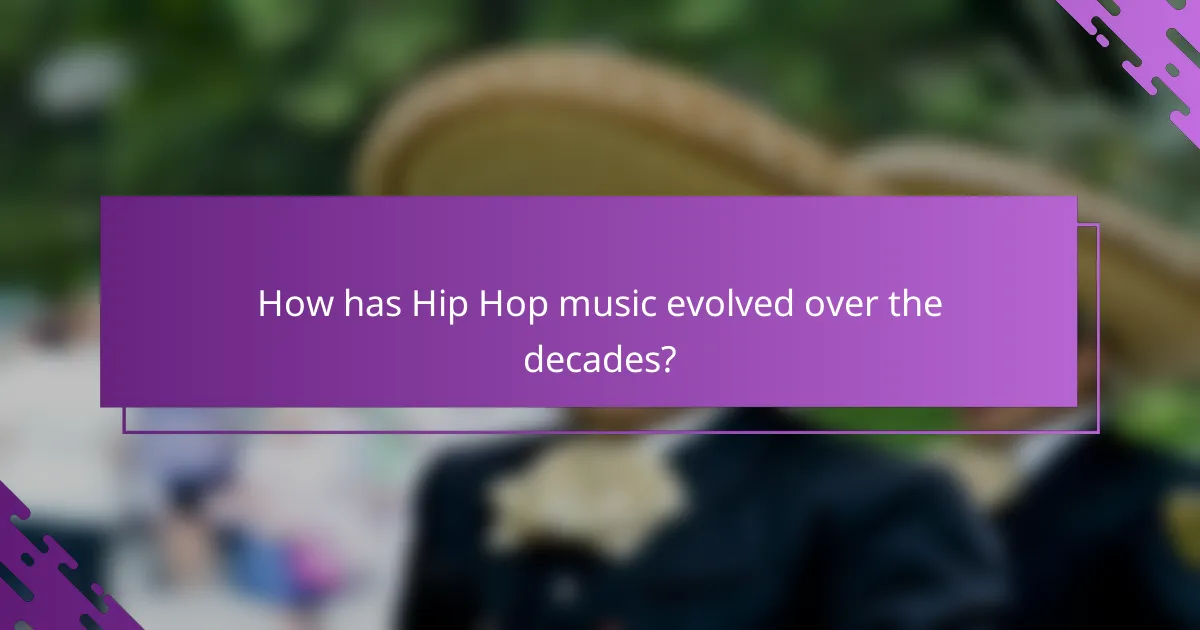
How has Hip Hop music evolved over the decades?
Hip Hop music has transformed significantly since its inception, reflecting changes in culture, technology, and societal issues. From its grassroots beginnings in the 1970s to its current global influence, each decade has brought distinct styles and themes that shape the genre today.
1980s: The birth of Hip Hop
The 1980s marked the emergence of Hip Hop as a recognized genre, characterized by its rhythmic beats and lyrical storytelling. Artists like Grandmaster Flash and the Furious Five, along with Run-D.M.C., laid the groundwork with their innovative use of turntables and rapping.
This decade saw the rise of breakdancing and graffiti art, which complemented the music and created a vibrant urban culture. The release of influential tracks such as “Rapper’s Delight” in 1979 helped to popularize Hip Hop beyond local communities, setting the stage for its future growth.
1990s: Golden Age of Hip Hop
The 1990s are often referred to as the Golden Age of Hip Hop, marked by a surge in creativity and diversity within the genre. Artists like Tupac Shakur, The Notorious B.I.G., and Nas explored complex themes such as social justice, identity, and street life, elevating the lyrical quality of the music.
This era also saw the emergence of sub-genres like gangsta rap and alternative Hip Hop, with labels like Death Row and Bad Boy Records leading the charge. The introduction of more sophisticated production techniques allowed for richer soundscapes, making Hip Hop a dominant force in the music industry.
2000s: Mainstream acceptance
By the 2000s, Hip Hop achieved widespread mainstream acceptance, with artists like Jay-Z, Eminem, and 50 Cent topping charts globally. This decade was characterized by collaborations across genres, blending Hip Hop with pop, rock, and R&B, which broadened its appeal.
Additionally, the rise of digital platforms and social media transformed how artists connected with fans and distributed their music. However, this period also faced criticism for commercialization, with some arguing that it diluted the genre’s original message and authenticity.

What are the major sub-genres of Hip Hop?
The major sub-genres of Hip Hop include East Coast Hip Hop, West Coast Hip Hop, and Southern Hip Hop, each characterized by distinct sounds, styles, and cultural influences. Understanding these sub-genres helps to appreciate the diversity within Hip Hop music and its evolution over time.
East Coast Hip Hop
East Coast Hip Hop originated in New York City and is known for its complex lyrics and intricate beats. This sub-genre often emphasizes storytelling and lyrical prowess, with artists like Nas and The Notorious B.I.G. showcasing these traits.
The production style typically features samples from jazz, funk, and soul, creating a rich auditory experience. Key elements include a focus on lyricism and a gritty, urban aesthetic that reflects the realities of life in East Coast cities.
West Coast Hip Hop
West Coast Hip Hop emerged from California, particularly Los Angeles, and is recognized for its laid-back, smooth sound and strong bass lines. This style often incorporates elements of funk and G-funk, with artists like Dr. Dre and Snoop Dogg leading the way.
Thematically, West Coast Hip Hop frequently discusses lifestyle, party culture, and social issues, often with a more relaxed delivery compared to its East Coast counterpart. The production often features synthesizers and melodic hooks, contributing to its distinctive vibe.
Southern Hip Hop
Southern Hip Hop, also known as Dirty South, has its roots in cities like Atlanta, Houston, and New Orleans. This sub-genre is characterized by its heavy use of bass, catchy hooks, and a more rhythmic flow, with artists such as OutKast and Lil Wayne exemplifying its style.
The production often includes elements of trap music, which features hi-hats, deep bass, and a slower tempo. Southern Hip Hop has played a significant role in shaping contemporary Hip Hop, influencing mainstream music trends and introducing new styles and sounds.
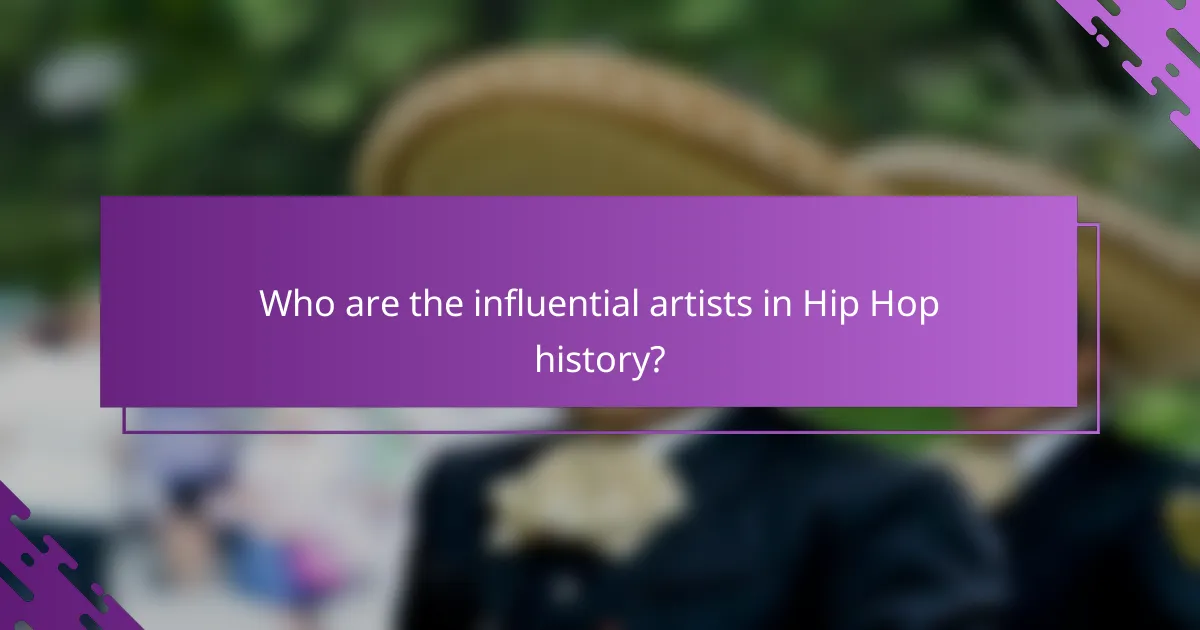
Who are the influential artists in Hip Hop history?
Influential artists in Hip Hop history have shaped the genre through their unique styles, impactful lyrics, and cultural significance. Key figures like Tupac Shakur, The Notorious B.I.G., and Jay-Z have left lasting legacies that continue to inspire new generations of artists and fans.
Tupac Shakur
Tupac Shakur, also known as 2Pac, is celebrated for his profound lyrical content that often addressed social issues, personal struggles, and the complexities of life in urban America. His ability to blend storytelling with powerful emotion made his music resonate deeply with listeners.
Shakur’s albums, such as “All Eyez on Me” and “Me Against the World,” showcase his versatility, ranging from hard-hitting anthems to introspective ballads. His influence extends beyond music, as he became a voice for marginalized communities and a symbol of resistance.
The Notorious B.I.G.
The Notorious B.I.G., or Biggie Smalls, is renowned for his smooth flow and vivid storytelling. His debut album, “Ready to Die,” introduced a new narrative style that combined street life with personal reflection, making his work relatable and impactful.
Biggie’s collaborations with artists like Puff Daddy and his posthumous releases solidified his status as a Hip Hop icon. His untimely death in the late 1990s only amplified his legacy, influencing countless artists who followed in his footsteps.
Jay-Z
Jay-Z has evolved from a street [censured] to a global business mogul, making him one of the most successful figures in Hip Hop. His debut album, “Reasonable Doubt,” established him as a lyrical powerhouse, while his subsequent works have explored themes of wealth, ambition, and social justice.
With numerous Grammy Awards and a diverse discography, Jay-Z’s impact on the genre is undeniable. He has also played a crucial role in mentoring new talent and advocating for social change, further cementing his influence in Hip Hop history.

What role does Hip Hop play in social commentary?
Hip Hop serves as a powerful medium for social commentary, allowing artists to express their views on societal issues, injustices, and personal experiences. Through rhythmic and lyrical storytelling, it highlights the struggles and triumphs of urban communities, making complex topics accessible to a broad audience.
Addressing systemic issues
Hip Hop often tackles systemic issues such as racism, poverty, and police brutality, reflecting the realities faced by marginalized communities. Artists use their platforms to raise awareness and provoke thought, encouraging listeners to engage with these critical topics.
For example, songs that discuss police violence can lead to increased public discourse and activism, as seen in tracks that resonate during social movements. This genre not only entertains but also educates, prompting listeners to consider their roles in addressing these challenges.
To effectively use Hip Hop as a tool for social commentary, artists should focus on authenticity and personal narratives. By sharing their own experiences and those of their communities, they can create a deeper connection with their audience, fostering empathy and understanding.
